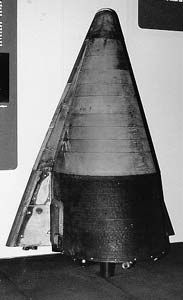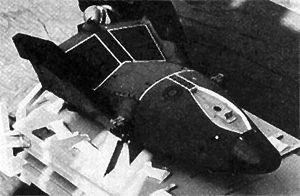
Home - Search - Browse - Alphabetic Index: 0- 1- 2- 3- 4- 5- 6- 7- 8- 9
A- B- C- D- E- F- G- H- I- J- K- L- M- N- O- P- Q- R- S- T- U- V- W- X- Y- Z
Asset
 Asset Credit: USAF |
AKA: ASV-3. Status: Operational 1963. Gross mass: 540 kg (1,190 lb). Height: 1.79 m (5.87 ft). Span: 1.53 m (5.01 ft).
After cancellation of Dynasoar, flights continued of subscale unmanned spaceplanes in order to obtain test data applicable to later vehicles.
After the cancellation of Dynasoar, the Air Force pursued further development of manned spaceplanes under the START Project. This included the ASSET and PRIME/X-23 suborbital launch of subscale lifting body designs and B-52 drop tests of the X-24A and X-24B lifting body designs into the mid-1970's.
The first of the series was a carry-over from the X-20 and was called ASSET ( 'Aerothermodynamic Elastic Structural Systems Environmental Tests'). The project began in 1960, purportedly to use subscale models of the X-20 Dynasoar to test materials prior to full-scale manned flights. It had been originally planned to use the Scout launch vehicle, but the program switched to surplus Thor missiles returned from the United Kingdom for the 4,000 m/s flights and the Thor-Delta for the 6,000 m/s flights. An aero-thermodynamic structural test vehicle (ASV) was used for heat shield tests. The spacecraft flew on a suborbital trajectory to the recovery zone at Ascension Island.
However was ASSET really so closely related to the DynaSoar or was this just a cover for an entirely different, lower cost, manned spaceplane design? Giuseppe De Chiara points out:
.recently I was involved in a cycle of lectures, concerning manned spacecraft configuration, at the Aerospace Engineering Dept. of the University of Naples.. the analyzing Gemini family. I found that the drawing of the Winged Gemini in your page (credited Glen Swanson) is completely wrong. This drawing is clearly taken by the Flight Manual of the Gemini .and modified with the addition of a mid-line sleek triangular wing and "subsystem interconnection" (??!!) on the bottom.As you said Winged Gemini was derived from the experience gained by the ASSET program. If you analyze the ASSET drawings you will find a bi-conic re-entry spacecraft with a low cranked arrow wing. Interestingly if scale-up the ASSET layout drawings you will match exactly Winged Gemini configuration (as portrayed in the other drawings).
These considerations put a new light on the ASSET (AEV and ASV) program - it seems clear that ASSET was never a subscale model of the X 20. In fact, there were a lot of configuration differences between the two vehicles, the former being a bi-conic shape with a very reduced wing without a vertical stabilizer, the latter was a "classic" hypersonic >75 deg degree delta wing with . two huge vertical stabilizers. It's also clear that the performances of the two vehicles (especially re-entry footprint crossrange) were completely different.
This leads (me) to think that ASSET could be a completely different spacecraft configuration later adopted by the hybrid Gemini capsule to increase its re-entry performance. The whole project was managed by Mc Donnell, which built both vehicles, under the cover of USAF funds (I always wondered why, if ASSET was a subscale model of X-20, why was it built by Mc Donnell, and not by Boeing, as prime contractor of the Dyna Soar project......?).
Following this train of thought it seems that the USAF (after cancellation of the X 20), continued to seek to have a small, and even cheaper, spaceplane obtained by the merging of the ASSET configuration and a Gemini spaceframe. Such a vehicle could be launched by a Titan II directly from a ICBM silo at Vandenberg AFB, in space interception mission with a highly secret profile.
| ASSET-AEV 1, 2 Lifting Body Reentry Test satellite operated by USAF, USA. |
| ASSET-ASV 1, 2, 3, 4 Lifting Body Reentry Test satellite operated by USAF, USA. |
Family: Spaceplane, Suborbital, US Rocketplanes. Country: USA. Launch Vehicles: Delta, Thor DSV-2G. Bibliography: 152, 158, 22, 48.
 | ASSET-ASV 1 Credit: Manufacturer Image |
 | X-23A Credit: USAF |
1960 During the Year - .
- ASSET Project begun. - . Nation: USA. Spacecraft Bus: Dynasoar. Spacecraft: Asset. ASSET ( 'Aerothermodynamic Elastic Structural Systems Environmental Tests') involved suborbital flight of a small scale spaceplane model to test structural and materials concepts for the X-20 Dynasoar to test materials prior to full-scale manned flights..
1961 May 29 - .
- Advanced Re-entry Technology program and SAINT II program. - . Nation: USA. Spacecraft: Asset, Dynasoar, SAINT, SAINT II. The Space Systems Division completed two development plans for an Advanced Re-entry Technology program and a SAINT II program..
1963 December 11 - .
- X-20 efforts important to other space programs be continued. - . Nation: USA. Spacecraft: Asset, Dynasoar. The Secretary of the Air Force directed that X-20 efforts important to other space programs be continued..
1963 December 13 - .
- X-20 phase-out plan. - . Nation: USA. Spacecraft: Asset, Dynasoar. The X-20 System Program Office completed the first phase-out plan, and the X-20 Engineering Office compiled a list of useful efforts for continuation..
1963 December 19 - .
- Allocation of X-20 hardware. - . Nation: USA. Spacecraft: Asset, Dynasoar. Representatives from various government agencies met at the system program office to determine the allocation of X-20 hardware..
1963 December 20 - .
- Dyna-Soar termination plan. - . Nation: USA. Spacecraft: Asset, Dynasoar. Both the system program office and engineering office completed revisions to the termination plan and the list of efforts for possible continuation..
1963 December 27 - .
- Dyna-Soar termination plan. - . Nation: USA. Spacecraft: Asset, Dynasoar. The program office again revised its termination plan..
1964 Jan - .
- ASSET program extended. - . Spacecraft Bus: Dynasoar. Spacecraft: Asset. In accordance with the Headquarters AFSC directive of 16 December 1963, Space Systems Division planned to expand the ASSET program and to establish a new program - STAR..
1964 January 3 - .
- Dyna-Soar termination plan. - . Nation: USA. Spacecraft: Asset, Dynasoar. Further revisions were made to the termination plan and the list of efforts for continuation..
1964 January 23 - .
- Asset project and other useful X-20 efforts to continue. - . Nation: USA. Spacecraft: Asset, Dynasoar. A final edition of the program office's termination plan was completed. USAF headquarters informed AFSC that the Secretary of the Air Force approved 36 tasks for continuation. for the continuaion of useful X-20 efforts..
1964 October 29 - . 03:35 GMT - . Launch Site: Cape Canaveral. Launch Complex: Cape Canaveral LC17B. LV Family: Thor. Launch Vehicle: Thor DSV-2F.
- ASSET 4 re-entry vehicle test flight - .
Nation: USA.
Agency: USAF.
Spacecraft: Asset.
Apogee: 50 km (31 mi).
Suborbital test of small scale spaceplane model to test structural concepts for the X-20 Dynasoar. Aero-environmental test vehicle (AEV) to test aerodynamic properties of flexing outer skin with corrugated columbium panel. Reached 4,000 m/s at 50.6 km altitude before being released from single-stage Thor SLV-2 launch vehicle. Telemetry received for 900 seconds until spaceplane had reached Mach 2 1200 km downrange. It then became unstable and crashed into the Atlantic. Recovery was not planned. AEV-1 was part of Space Systems Division's Aerothermodynamic/ elastic Structural Systems Evaluation Test (ASSET) program, and the first of two tests to obtain data on structural behavior during reentry, with emphasis on thermoelastic effects.
1965 March 3 - .
- X-24 maneuverable reentry vehicle announced as a follow-on to the ASSET spaceplane. - .
Related Persons: Schriever.
Spacecraft: Asset,
X-24,
Prime.
General Bernard A. Schriever, Commander, AFSC, announced plans to develop a wingless, maneuverable reentry vehicle (SV-5) as a follow-on to the ASSET spaceplane. The new vehicle was under Space Systems Division management and was part of the new Precision Recovery Including Maneuvering Reentry (PRIME) program. Both PRIME and the ASSET programs were part of the larger Spacecraft Technology and Advanced Reentry Test (START) program.
1966 February 11 - .
- PRIME and PILOT reentry vehicle plans approved. - .
Spacecraft: Asset,
X-24,
Prime.
Headquarters USAF informed AFSC that both the Precision Recovery Including Maneuvering Reentry (PRIME) and PILOT low-speed reentry vehicle program development plans had been approved. PRIME, PILOT, the Aerothermodynamic/ Elastic Structural Systems Environmental Tests (ASSET) program, and Advanced Maneuvering Entry were all new projects within the Spacecraft Technology and Advanced Reentry Tests (START) program managed by Space Systems Division.
Back to top of page
Home - Search - Browse - Alphabetic Index: 0- 1- 2- 3- 4- 5- 6- 7- 8- 9
A- B- C- D- E- F- G- H- I- J- K- L- M- N- O- P- Q- R- S- T- U- V- W- X- Y- Z
© 1997-2019 Mark Wade - Contact
© / Conditions for Use